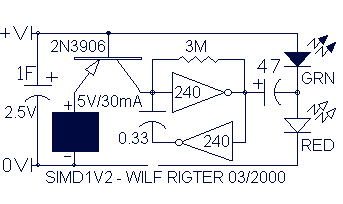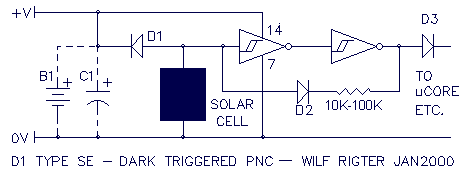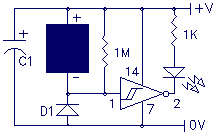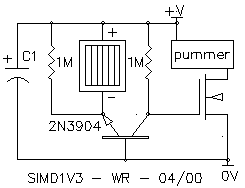
Wilf Rigter`s SIMD1 V2

In the never-ending quest for simplicity, even one extra diode is a price I loathe to pay. To avoid using extra components, it struck me that the two diodes in SIMD1 V1 were connected like the two junctions in one transistor. Eureka! Replace two diodes with one transistor to restore the original component. Now one whole transistor is more than the sum of its two diode junction parts, and on closer examination, it became clear that I had fortuitously solved another problem.
The circuit under discussion involves the replacement of two diodes with a single transistor, which can streamline the design and improve efficiency. In this configuration, the two diodes are typically used in a rectifying or switching application, where they are arranged in a manner that mimics the behavior of a transistor.
To implement this design, a bipolar junction transistor (BJT) or a field-effect transistor (FET) can be utilized. The transistor will serve as a single active component that can conduct in both directions, akin to the forward-biased condition of diodes. In this arrangement, the base (or gate) of the transistor can be controlled to turn the device on or off, effectively replacing the two diodes while maintaining functionality.
The advantages of this approach include reduced component count, which can lead to a more compact circuit design, as well as potentially improved thermal performance and reduced voltage drop across the device. Additionally, transistors can provide better switching characteristics compared to diodes, thus enhancing the overall performance of the circuit.
When designing the circuit, it is essential to consider the specifications of the transistor to ensure it can handle the expected current and voltage levels. Proper biasing and protection mechanisms should also be incorporated to prevent damage to the transistor during operation.
This innovative solution exemplifies how a deeper understanding of electronic components can lead to more efficient designs, reducing complexity while enhancing performance.In the never-ending quest for simplicity even one extra diode is a price I loath to pay and to avoid using extra components it struck me that the the two diodes in SIMD1 V1 were connected like the two junctions in one transistor. Eureka! replace two diodes with one transistor to restore the original component. Now one whole transistor is more than the sum of it`s two diode junction parts and on closer examination, it became clear that I had fortuitously solved another problem.
🔗 External reference
The circuit under discussion involves the replacement of two diodes with a single transistor, which can streamline the design and improve efficiency. In this configuration, the two diodes are typically used in a rectifying or switching application, where they are arranged in a manner that mimics the behavior of a transistor.
To implement this design, a bipolar junction transistor (BJT) or a field-effect transistor (FET) can be utilized. The transistor will serve as a single active component that can conduct in both directions, akin to the forward-biased condition of diodes. In this arrangement, the base (or gate) of the transistor can be controlled to turn the device on or off, effectively replacing the two diodes while maintaining functionality.
The advantages of this approach include reduced component count, which can lead to a more compact circuit design, as well as potentially improved thermal performance and reduced voltage drop across the device. Additionally, transistors can provide better switching characteristics compared to diodes, thus enhancing the overall performance of the circuit.
When designing the circuit, it is essential to consider the specifications of the transistor to ensure it can handle the expected current and voltage levels. Proper biasing and protection mechanisms should also be incorporated to prevent damage to the transistor during operation.
This innovative solution exemplifies how a deeper understanding of electronic components can lead to more efficient designs, reducing complexity while enhancing performance.In the never-ending quest for simplicity even one extra diode is a price I loath to pay and to avoid using extra components it struck me that the the two diodes in SIMD1 V1 were connected like the two junctions in one transistor. Eureka! replace two diodes with one transistor to restore the original component. Now one whole transistor is more than the sum of it`s two diode junction parts and on closer examination, it became clear that I had fortuitously solved another problem.
🔗 External reference



